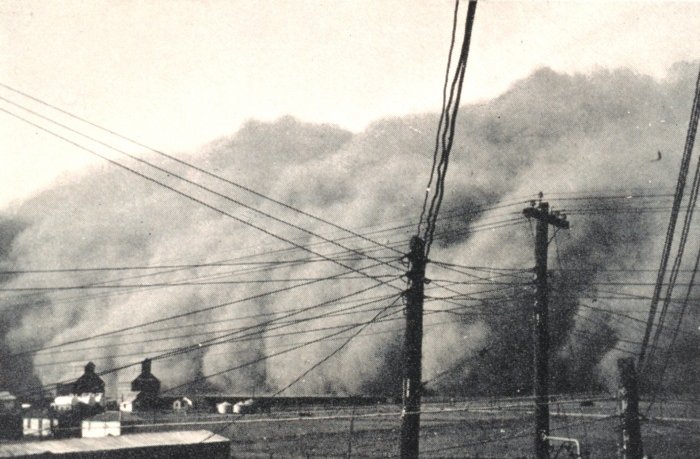Phoenix Dust Storm Hearkens Back to the Worst Hard Time

A dust storm bears down on Spearman, Texas, in 1935 (U.S. National Oceanic and Atmospheric Administration).
If you haven’t seen the incredible images of the recent dust storm that swept across Phoenix, check out this YouTube video. It brought to mind a book that I read last year, The Worst Hard Time, an award-winning chronicle of the Dust Bowl by Timothy Egan.
In the 1930s, massive dust storms roared across multiple states, blotting out the sun and creating such complete darkness that people got lost going from the house to the barn, and some perished trying. The dust storms rose so high in the sky that they played havoc with airplanes. Egan describes one devastating dust storm that struck on what became known as Black Sunday:
“When the big roller crossed into Kansas, it was reported to be two hundred miles wide, with high winds like a tornado turned on its side. In Denver, temperatures dropped twenty-five degrees in an hour and then the city fell into a haze. The sun was blocked. That was just the western edge of the storm. The front end charged into Kansas carrying soil from four states. Near the town of Hays, where Germans from Russia had settled fifty years earlier, a small boy who had been playing in the fields with a friend dashed for home. He got lost in the midday blackness; confused, he circled back. The next day he was found dead. He had suffocated, half a mile from home.”
“It was like three midnights in a jug,” added one old-timer.
People got sick and some died from ingesting so much airborne soil. As Egan describes it, “The doctor had looked inside an otherwise healthy young farm hand, a man in his early twenties, and told him what he saw. ‘You are filled with dirt,’ the doctor said. The young man died within a day.”Â
A bizarre side effect was that the dust storms created high levels of static electricity that sent blue flames of current down wires. One man said the static electricity was powerful enough to kill a jackrabbit; he had seen it happen with his own eyes.
The Dust Bowl erupted because of a confluence of disastrous conditions. No rain, high temperatures, and the plowing under of grasslands to plant wheat instead. The thick grass of the prairie held the soil in place, but wheat was more profitable. Unusually good weather in the 1920s had led to record harvests of wheat, so farmers aggressively plowed up more and more prairie with the encouragement of the government. As the Federal Bureau of Soils put it at the time, “The soil is the one indestructible, immutable asset that the national posses. It is the one resource that cannot be exhausted, that cannot be used up.”
Those words would come back to haunt the government and the farmers. When the temperatures soared and the land dried up, the soil began to march across the country in monster storms that became known as Black Blizzards.
July of 2011, which has mercifully come to an end, has seen record-breaking heat. But it was even worse during the Worst Hard Time. In his 1936 diary, one farmer described it this way: “Very dusty, windy, mean…July was the worst month (so far) of the worst year ever known.”
By Doug Peterson
